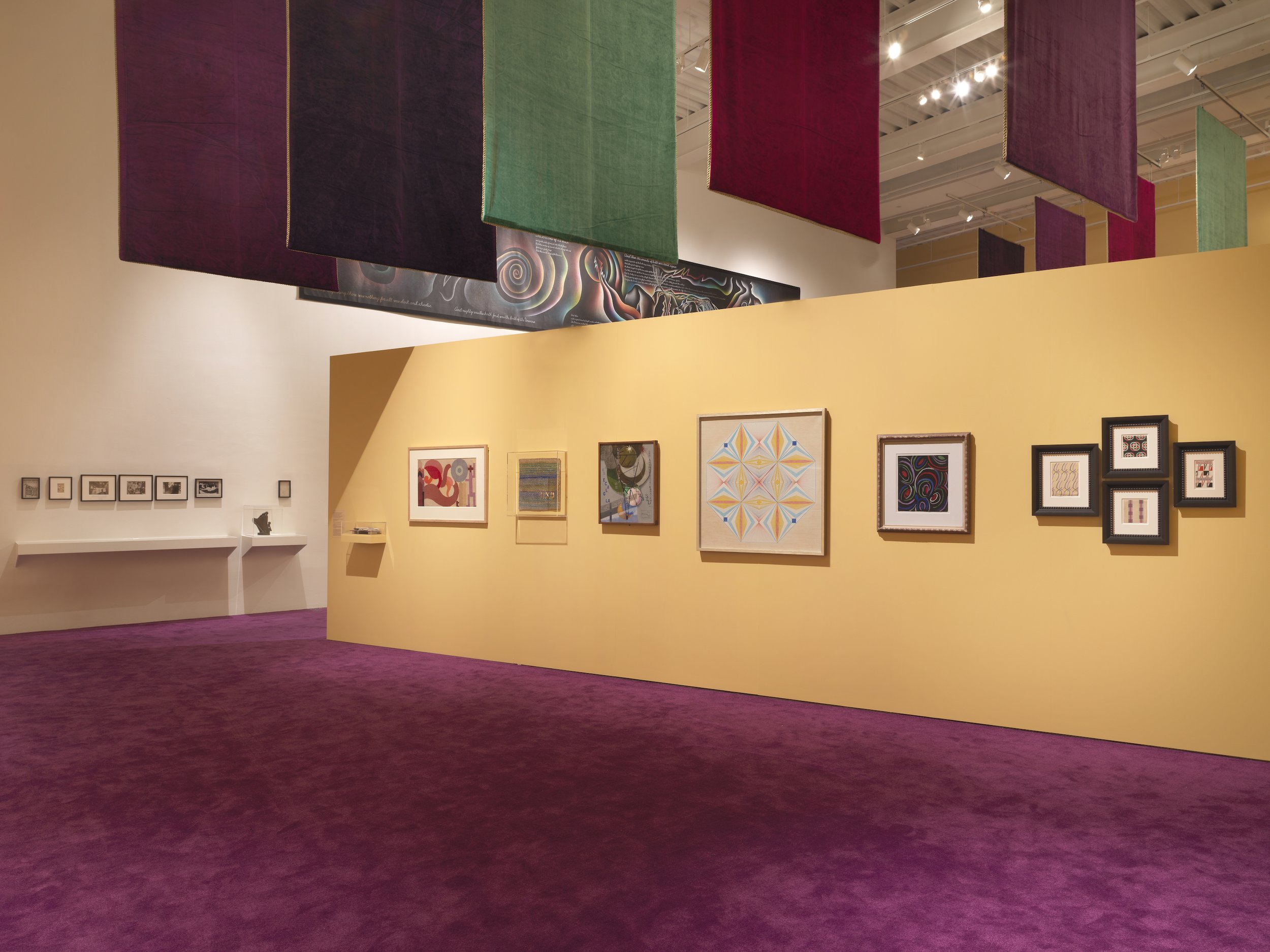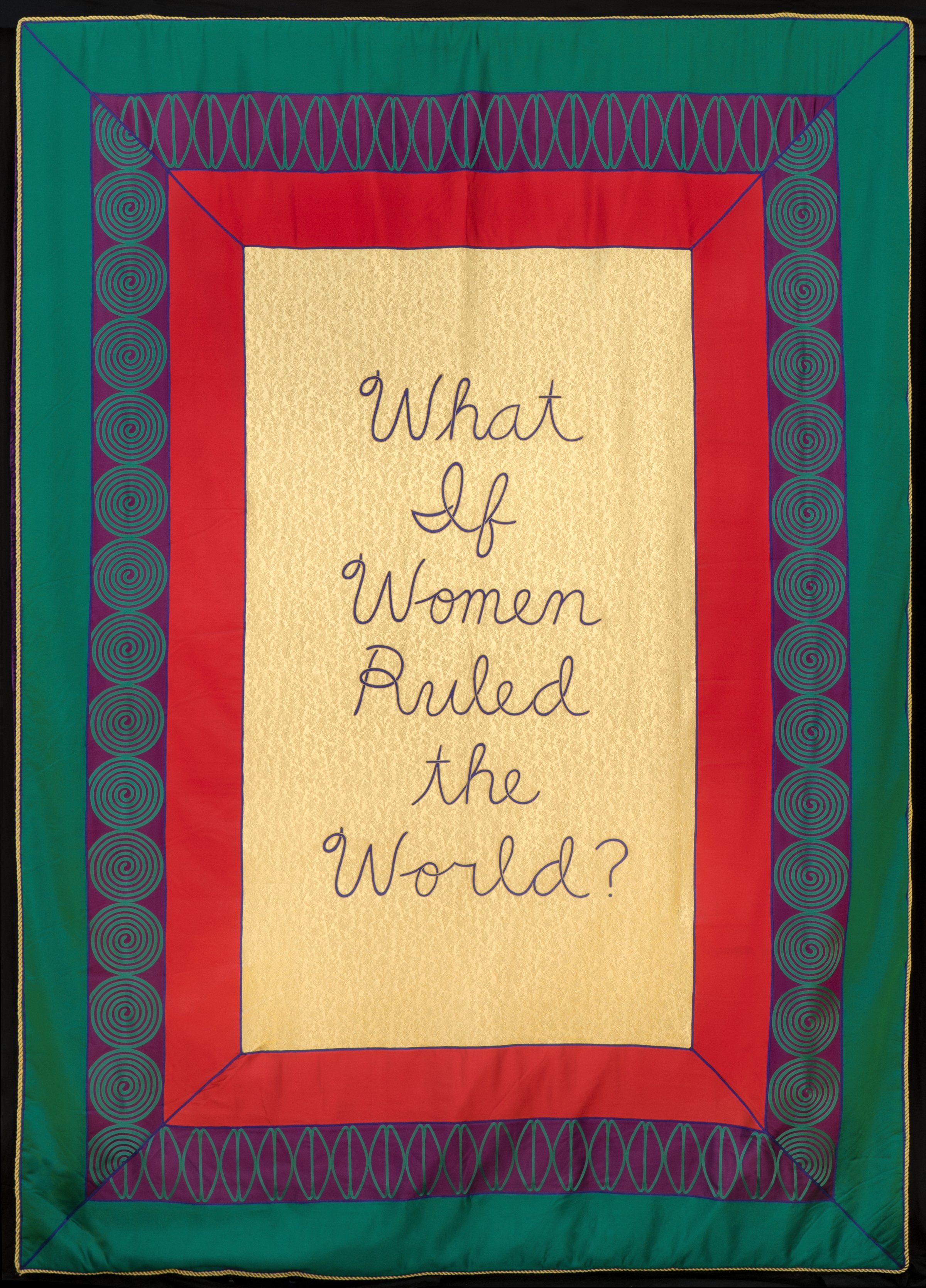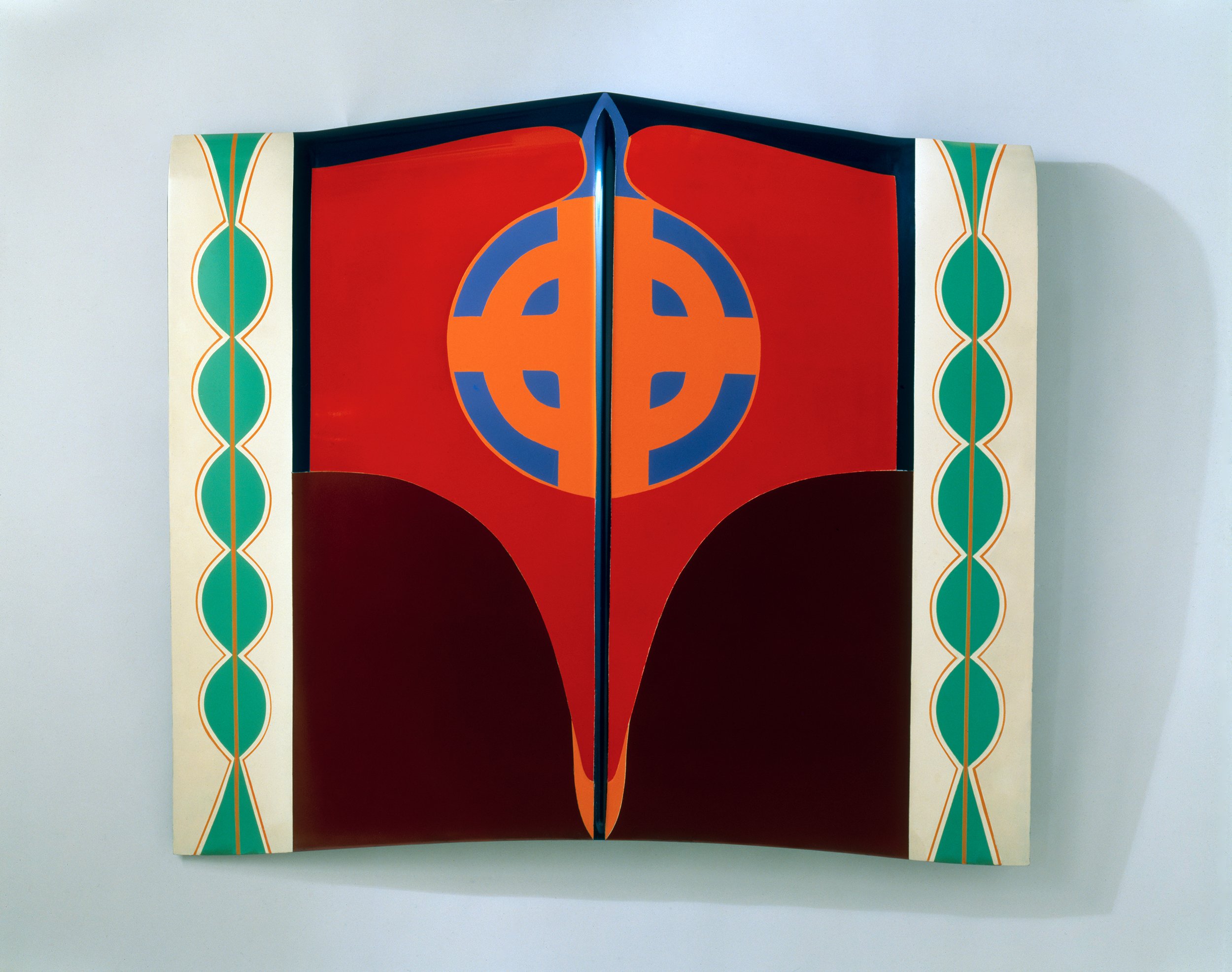Judy Chicago: Herstory
What if Women Ruled the World? From “The Female Divine,” 2020. Embroidery and brocade on velvet-backed fabric, 204 x 144 x 1/2 in (518.16 x 365.76 x 1.27 cm). © Judy Chicago/Artists Rights Society (ARS). Jordan Schnitzer Family Foundation
New York, NY The New Museum opened on October 12, 2023, with “Judy Chicago: Herstory,” it brings together six decades of the artist’s work and including an exhibition with the exhibition spotlighting women essential to the history of art and Chicago’s own practice. It will be on view through March 3, 2024; Chicago’s most comprehensive New York museum survey to date spans three floors of the New Museum, tracing the artist’s sixty-year career across painting, sculpture, installation, drawing, textiles, photography, stained glass, needlework, and printmaking. On the Museum’s Fourth Floor, a total installation featuring Chicago's embroideries, sculptures, drawings, and carpet design contextualizes her practice by bringing together artworks and archival materials from more than eighty women artists, writers, and cultural figures, including Hilma af Klint, Hildegard of Bingen, Claude Cahun, Elizabeth Catlett, Simone de Beauvoir, Artemisia Gentileschi, Emma Goldman, Frida Kahlo, Georgia O'Keeffe, Charlotte Salomon, Remedios Varo, and Virginia Woolf, among others. Titled after fifteenth century author Christine de Pisan’s “Le Livre de la Cité des Dames,” “The City of Ladies” continues Chicago's work as a feminist activist and cultural historian claiming space for women in narratives that previously obscured or denied their contributions—much like her seminal work The Dinner Party (1974–79) in its attempt to create a history of important and often overlooked women.
Birth Trinity: Needlepoint 1, from the Birth Project, 1983. Needlepoint on mesh canvas, 51 x 130 in (129.5 x 330.2 cm). Needlepoint by Susan Bloomenstein, Elizabeth Colten, Karen Fogel, Helene Hirmes, Bernice Levitt, Linda Rothenberg, and Miriam Vogelman. © Judy Chicago/Artists Rights Society (ARS), New York. The Gusford Collection. Photo: Donald Woodman/Artists Rights Society (ARS), New York
“Judy Chicago: Herstory” will encompass the entirety of Chicago’s practice, from her 1960s experiments in Minimalism and her revolutionary feminist art of the 1970s to her series of the 1980s and 1990s—such as the Birth Project (1980–85), PowerPlay (1982–87), Holocaust Project (1985–93), Resolutions: A Stitch in Time (1994–2000), and The End: A Meditation on Death and Extinction (2012-1018)—which expand the purview of her Second Wave Feminist agenda to confront environmental disaster, genocide, social inequity, birth and creation, mortality, and the construct of masculinity. The exhibition includes legendary works such as Rainbow Pickett (1965), originally presented in “Primary Structures” at the Jewish Museum, an exhibition which consecrated the minimalist turn in contemporary sculpture; Atmospheres, her radical performances initiated in 1969 employing colored smoke and fireworks to activate rather than scar the landscape; a suite of visionary abstractions from the 1970s—such as Through The Flower (1973) and the Great Ladies series (1973)—exemplifying Chicago’s iconography rooted in feminist theory; the Birth Project, a cycle of dozens of works begun in 1980 combining needlework, embroidery, and painting to celebrate the birth process; and documentation of “Womanhouse,” the fabled 1972 installation staged in an abandoned Hollywood mansion by Chicago and Miriam Schapiro’s Feminist Art Program. These historic works are joined by recent series including The End: A Meditation on Death and Extinction (2012–18), exploring death as it affects both individuals and the planet, and The Female Divine (2022), a series of eleven monumental banners designed by Chicago and produced by the nonprofit Chanakya School of Craft in Mumbai posing questions such as “What if Women Ruled the World?” Tracing her prolific practice across many decades and intersecting art movements, “Herstory” demonstrates the vast range and impact of Judy Chicago’s work over more than half a century.
























“Judy Chicago: Herstory,” 2023. Exhibition view: New Museum, New York. Courtesy New Museum. Photo: Dario Lasagni
The exhibition will also explore Chicago’s manifold contributions as a feminist activist and cultural historian, presenting her work in dialogue with other women artists, writers, and thinkers whose memory she has helped keep alive through her tireless activities as both researcher and historical preservationist. Combining artworks and source materials in a distinctive exploration of artistic influences and reverberations across history, this exhibition proposes a new, radical model for a solo exhibition—an “introspective,” rather than a retrospective. In this collaborative curatorial approach, the artist is invited to conceive a personal museum based on a model of historiography that is porous, hospitable, and accepting. “The City of Ladies” includes work and archival materials from Hilma af Klint, Eileen Agar, Anni Albers, Lola Álvarez Bravo, Anna Atkins, Alice Austen, Djuna Barnes, Simone de Beauvoir, Otti Berger, Annie Besant, Hildegard of Bingen, Rosa Bonheur, Marianne Brandt, Nannie Burroughs, Claude Cahun, Julia Margaret Cameron, Leonora Carrington, Countess Virginia Oldoini Verasis di Castiglione, Elizabeth Catlett, Pop Chalee, Elizabeth S. Clarke, Ithell Colquhoun, Imogen Cunningham, Sonia Delaunay, Maya Deren, Emily Dickinson, Sophie Drinker, Suzanne Duchamp, Leonor Fini, Elsa von Freytag-Loringhoven, Olga Fröbe-Kapteyn, Artemisia Gentileschi, Gluck (Hannah Gluckstein), Emma Goldman, Natalia Goncharova, Martha Graham, Alice Guy-Blaché, Florence Henri, Barbara Hepworth, Hannah Höch, Kati Horna, Georgiana Houghton, Zora Neale Hurston, Frida Kahlo, Gertrude Käsebier, Käthe Kollwitz, Emma Kunz, Dorothea Lange, Edmonia Lewis, Mina Loy, Dora Maar, Jeanne Mammen, Maria Martinez, Maria Martins, Mary Louise McLaughlin, Maria Sibylla Merian, Paula Modersohn-Becker, Louise Nevelson, Maria Longworth Nichols Storer, Anaïs Nin, Georgia O’Keeffe, Méret Oppenheim, Agnes Pelton, Mary Richardson, Margaret Sanger, Augusta Savage, Ethel Smyth, Gertrude Stein, Varvara Stepanova, Florine Stettheimer, Dorothea Tanning, Sophie Taeuber-Arp, Toyen, Sojourner Truth, Remedios Varo, Pablita Velarde, Beatrice Wood, Virginia Woolf, and Unica Zürn, as well as a number of unattributed works.
Judy Chicago and Donald Woodman, Rainbow Shabbat, 1992. Stained glass, 54 x 204 in (137.2 x 518.2 cm). Fabrication by Bob Gomez; glass painting by Dorothy Maddy. © Judy Chicago/Artist Rights Society (ARS), New York. © Donald Woodman/Artist Rights Society (ARS), New York. Jordan Schnitzer Family Foundation
Contextualizing Chicago’s feminist methodology within the many art movements in which she participated—and from whose histories she has frequently been erased—“Herstory” showcases Chicago’s tremendous impact on American art and highlights her critical role as a cultural historian claiming space for women often omitted from various canons. Part-expanded self portrait and part-historical, revisionist archive, “Herstory,” will be both a solo exhibition and a polyphonic survey of the feminist arts over multiple centuries.
Car Hood, 1964. Sprayed acrylic lacquer on car hood, 42 7/8 x 49 1/8 x 4 1/8 in (108.9 x 124.8 x 10.8 cm). © Judy Chicago/Artists Rights Society (ARS), New York. Moderna Museet, Stockholm. Purchase 2007 (The Second Museum of Our Wishes), MOM/2007/149. Photo: Donald Woodman/Artists Rights Society (ARS), New York
“Judy Chicago: Herstory” is curated by Massimiliano Gioni, Edlis Neeson Artistic Director, Gary Carrion-Murayari, Kraus Family Senior Curator, Margot Norton, former Allen and Lola Goldring Senior Curator at the New Museum and current Chief Curator at the Berkeley Art Museum and Pacific Film Archive, and Madeline Weisburg, Assistant Curator. The exhibition will be accompanied by a fully illustrated catalogue co-published by Phaidon and the New Museum, featuring texts by Glenn Adamson, Connie Butler, Gary Carrion-Murayari, Ann Goldstein, Jennifer Higgie, Candice Hopkins, Amelia Jones, Quinn Latimer, Margot Norton, Kymberly Pinder, Ian Wallace, Madeline Weisburg, and Carmen Winant; and an interview between the artist and Massimiliano Gioni.
SUPPORT
Lead sponsorship of “Judy Chicago: Herstory” is provided by DIOR.
Major support is provided by The Artemis Council of the New Museum* Jordan Schnitzer/The Harold & Arlene Schnitzer CARE Foundation..
The New Museum gratefully acknowledges the Artistic Director’s Circle of the New Museum: Dakis Joannou, Co-Chair; Eugenio Lopez, Co-Chair; Gael Neeson, Co-Chair; Shane Akeroyd, Pietro Beccari, Abbie and Patrick Dean, Susan Hayden, J. Tomilson and Janine Hill, Carola Jain, Richard Mumby, Holly Peterson, Elham and Tony Salamé, and Beth Swofford. Additional support is provided by: Sabrina Buell and Yves Behar, DMINTI & DANAE, Jay Franke and David Herro, The Gladys Krieble Delmas Foundation, Grażyna Kulczyk Collection, Hill Art Foundation, Marley Blue Lewis, Kathleen O’Grady / The O’Grady Foundation, Debbie and Mitchell Rechler, Judy Rechler, Samuel H. Kress Foundation, Margherita Stabiumi, Younghee Kim-Wait, and Lisa Watson and Mike Krupka. Support for the accompanying publication has been provided by the J. McSweeney and G. Mills Publications Fund at the New Museum. Special thanks to Jeffrey Deitch, New York/Los Angeles and Jessica Silverman, San Francisco. *Artemis Council Members: Maria Baibakova, Co-Chair, Nicole Nunag, Co-Chair, Dr. Shelley Fox Aarons, Alison Blood, Lisa Burnes, Cheryl Chan, Jacqueline Clements, Anna Maria Gonzales Cuevas, Ingrid Cincala Gilbert, Kaleta A. Doolin, Heather Flow, Molly Gochman, Stacey Goergen, Kimberly Gould, Agnes Gund, Vanessa Guo, Lynette Hayde, Christina Hribar, Justine Leguizamo, Lucy Liu, Jennifer Lotz, Justine McEnerney, Jessica Paindiris, Holly Peterson, Debbie Rechler, Barrie S. Roman, Chiara Rusconi, Nicole Salmasi, Arielle Schnitzer, Tracey Serko, Julie Simpson, Jennifer Soros, Lynda Stern, Sara Story, Alva Stux, Vicki Match Suna, Roxann Taylor, Nicola Vassell, Younghee Kim-Wait and Alexandra Wait, Olivia Walton, Madeline Weinrib, Demetria White, Sue Hostetler Wrigley, Tiffany Zabludowicz, Ruoqi Amy Zhou, Afrodet Zuri, Aimée Mullins, Ambassador and H. R. H. Princess Eugenie of York, Ambassador.
ABOUT NEW MUSEUM
The New Museum is the only museum in New York City exclusively devoted to contemporary art. Founded in 1977, the New Museum is a center for exhibitions, information, and documentation about living artists from around the world. From its beginnings as a one-room office on Hudson Street to the inauguration of its first freestanding building on the Bowery designed by SANAA in 2007, the New Museum continues to be a place of experimentation and a hub of new art and new ideas.
For more information about this exhibition and others, please visit the New Museum website for updates. The New Museum can also be found on Instagram.



